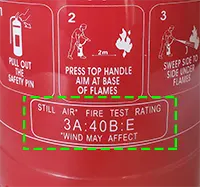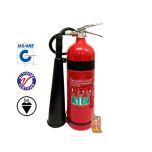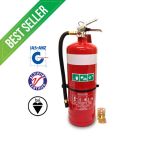 In Australia, the letters and numbers represent the type and size of fire that an extinguisher can handle, formulating its rating. You should have the right fire extinguisher ratings for your home or business premises, or you may not meet current regulations.
In Australia, the letters and numbers represent the type and size of fire that an extinguisher can handle, formulating its rating. You should have the right fire extinguisher ratings for your home or business premises, or you may not meet current regulations.
Below is a detailed overview of what the letters and numbers on a fire extinguisher mean and what they indicate about its efficiency against certain types of fires.
| 3 | A | 40 | B | E |
| Rating tested to a specific size of a wood fire | Fire type: combustible materials such as wood, paper, and fabric | Rating tested to a specific fuel load of a flammable liquid fire | Fire type: flammable liquids such as petrol, turpentine or paint | Fire type: electrical equipment such as appliances, computers, phones |
Letters classification: types of fire
In Australia, there are six classes or types of fire: A, B, C, D, E, and F.
- A fires rating: combustible materials such as wood, paper, and fabric.
- B fires rating: flammable liquids such as petrol, turpentine or paint
- C fires rating: flammable gases like LPG, hydrogen, butane or methane
- D fires rating: combustible metals such as magnesium, aluminum or potassium
- E fires rating: electrical equipment such as appliances, computers, phones
- F fires rating: cooking oils and fats typically a chip-pan fire
When a fire extinguisher is rated for more than one class of fire, it is expressed in alphabetical order, eg. 2A:40B(E)
So for example, our most popular extinguisher the 4.5kg Dry Chemical Powder has a rating of 4A:60B:C:E which means it is rated for A, B, C and E fire types.
Our 3.5kg CO2 Extinguisher has a rating of 5B:E which means it is rated for B and E fire types.
Now that we have explained the letters component, let's discuss the numbers on your extinguisher.
Numbers rating: sizes of fire
The number in front of the letter is used to rate the performance of an extinguisher during testing, based on its fire extinguishing potential, as outlined in Australian Standards AS/NZS 1850.
- A fires number rating: combustible materials
Rating numbers range from 1 to 10: possible ratings are 1A, 2A, 3A, 4A, 6A, 10A , those numbers relate to the fuel load of wooden crib used during testing. The higher the number, the greater the fuel load of the test fire.
- B fires number rating: flammable liquids
Rating numbers range from 2 to 80: possible ratings are 2B, 5B, 10B, 20B, 30B, 40B, 60B, 80B, those numbers relate to the fuel load of flammable liquid (n-heptane or hydocarbone solvent) used during testing. The higher the number, the greater the fuel load of the test fire.
- C fires number rating: flammable gases
C fires do not come with a rating number: the rating test simply determines if the extinguisher is capable of extinguishing a liquid propane gas test fire.
- D fires number rating: combustible metals
D fires do not come with a rating number: these are typically tested to international standards.
- E fires number rating: electrical equipment
E fires do not come with a rating number: the rating test simply determines if the extinguisher is capable of extinguishing an electrically energised equipment.
- F fires number rating: cooking oils
numbers range from 1 to 4: possible ratings are 1F (0.07m2), 2F, 3F, 4F (0.5m2), those numbers relate to the surface area of the pan or tray used during testing (with sunflower oil). The higher the number, the larger the test fire.
How do you rate a fire extinguisher?
All our extinguishers have been tested by BSI (British Standards Institution) and accredited by JAS-ANZ (Joint Accreditation System of Australia and New Zealand).
The CSIRO ActivFire Scheme is an Australian Government Agency who verify & certify fire products which may be installed into Federal and State Government Departments. All our extinguishers are also ActivFire certified.
Fire extinguisher rating requirements:
Your local fire safety company might have given you a list of fire rating requirements, rather than a list of extinguisher models. Below we have outlined those rating requirements against the required models.
If your extinguisher rating requirement is not included below, do not worry, you can pick a higher rated extinguisher to be 100% compliant.
Our Class A Rated Fire Extinguishers
Possible ratings are 1A, 2A, 3A, 4A, 6A, 10A , those numbers relate to the fuel load of wooden crib used during testing. The higher the number, the greater the fuel load of the test fire.
| Rating Required | Our Extinguishers Ratings | Our Extinguishers Models |
| 1A | 1A:10B:C:E | 0.75kg Dry Powder ABE |
| 1A | 1A:20B:C:E | 1kg Dry Powder ABE |
| 1A | 1A:3F | 2L Wet Chemical |
| 1A | 1A:E | MRI Sapphire |
| 2A | 2A:30B:C:E | 1.5kg Dry Powder ABE |
| 2A | 2A:30B:C:E | 2kg Dry Powder ABE |
| 2A | 2A | 4L F-500 Lithium-Ion Battery |
| 3A | 3A | 9L Air Water |
| 3A | 3A | 9L F-500 Lithium-Ion Battery |
| 3A | 3A:20B | 9L Eco Foam |
| 3A | 3A:20B | 9L Fluorine Free Foam |
| 3A | 3A:4F | 7L Wet Chemical |
| 3A | 3A:40B:C:E | 2.5kg Dry Powder ABE |
| 4A | 4A:60B:C:E | 4.5kg Dry Powder ABE |
| 4A | 4A:80B:C:E | 4.5kg Dry Powder ABE Hi-Performance |
| 6A | 6A:80B:C:E | 9kg Dry Powder ABE |
| 10A | 10A:80B:C:E | 25kg Dry Powder ABE |
| 10A | 10A:80B:C:E | 50kg Dry Powder ABE |
Our Class B Rated Fire Extinguishers
Possible ratings are 2B, 5B, 10B, 20B, 30B, 40B, 60B, 80B, those numbers relate to the fuel load of flammable liquid used during testing. The higher the number, the greater the fuel load of the test fire.
| Rating Required | Our Extinguishers Ratings | Our Extinguishers Models |
| 2B | 2B:E | 2kg Carbon Dioxide CO2 |
| 5B | 5B:E | 3.5kg Carbon Dioxide CO2 |
| 5B | 5B:E | 5kg Carbon Dioxide CO2 |
| 10B | 1A:10B:C:E | 0.75kg Dry Powder ABE |
| 20B | 1A:20B:C:E | 1kg Dry Powder ABE |
| 20B | 3A:20B | 9L ECO Foam |
| 20B | 3A:20B | 9L Fluorine Free Foam |
| 30B | 2A:30B:C:E | 1.5kg Dry Powder ABE |
| 30B | 2A:30B:C:E | 2kg Dry Powder ABE |
| 40B | 3A:40B:C:E | 2.5kg Dry Powder BE |
| 40B | 40B:E | 4.5kg Dry Powder BE |
| 60B | 4A:60B:C:E | 4.5kg Dry Powder ABE |
| 80B | 4A:80B:C:E | 4.5kg Dry Powder ABE Hi-Performance |
| 80B | 80B:E | 9kg Dry Powder BE |
| 80B | 6A:80B:C:E | 9kg Dry Powder ABE |
| 80B | 10A:80B:C:E | 25kg Dry Powder ABE |
| 80B | 10A:80B:C:E | 50kg Dry Powder ABE |
Our Class C Rated Fire Extinguishers
C fires do not come with a rating number: the rating test simply determines if the extinguisher is capable of extinguishing a flammable gas fire.
| Rating Required | Our Extinguishers Ratings | Our Extinguishers Models |
| C | 1A:10B:C:E | 0.75kg Dry Powder ABE |
| C | 1A:20B:C:E | 1kg Dry Powder ABE |
| C | 2A:30B:C:E | 1.5kg Dry Powder ABE |
| C | 2A:30B:C:E | 2kg Dry Powder ABE |
| C | 3A:40B:C:E | 2.5kg Dry Powder ABE |
| C | 4A:60B:C:E | 4.5kg Dry Powder ABE |
| C | 4A:80B:C:E | 4.5kg Dry Powder ABE Hi-Performance |
| C | 6A:80B:C:E | 9kg Dry Powder ABE |
| C | 10A:80B:C:E | 25kg Dry Powder ABE |
| C | 10A:80B:C:E | 50kg Dry Powder ABE |
Our Class D Rated Fire Extinguishers
D fires do not come with a rating number: these are typically tested to international standards.
| Rating Required | Our Extinguishers Ratings | Our Extinguishers Models |
| D | Not Applicable | Amerex 570 |
| D | Not Applicable | Amerex C571 |
Our Class E Rated Fire Extinguishers
E fires do not come with a rating number: the rating test simply determines if the extinguisher is capable of extinguishing an electrically energised equipment.
| Rating Required | Our Extinguishers Ratings | Our Extinguishers Models |
| E | 2B:E | 2kg Carbon Dioxide CO2 |
| E | 5B:E | 3.5kg Carbon Dioxide CO2 |
| E | 5B:E | 5kg Carbon Dioxide CO2 |
| E | 1A:10B:E | 0.75kg Dry Powder ABE |
| E | 1A:20B:E | 1kg Dry Powder ABE |
| E | 2A:30B:E | 1.5kg Dry Powder ABE |
| E | 2A:30B:E | 2kg Dry Powder ABE |
| E | 3A:40B:E | 2.5kg Dry Powder BE |
| E | 40B:E | 4.5kg Dry Powder BE |
| E | 4A:60B:E | 4.5kg Dry Powder ABE |
| E | 4A:80B:E | 4.5kg Dry Powder ABE Hi-Performance |
| E | 80B:E | 9kg Dry Powder BE |
| E | 6A:80B:E | 9kg Dry Powder ABE |
| E | 10A:80B:E | 25kg Dry Powder ABE |
| E | 10A:80B:E | 50kg Dry Powder ABE |
Our Class F Rated Fire Extinguishers
Possible ratings are: 1F (0.07sqm), 2F, 3F, 4F (0.5sqm), those numbers relate to the surface area of the pan or tray used during testing (with sunflower oil). The higher the number, the larger the test fire.
| Rating Required | Our Extinguishers Ratings | Our Extinguishers Models |
| 3F | 1A:3F | 2L Wet Chemical |
| 4F | 3A:4F | 7L Wet Chemical |


